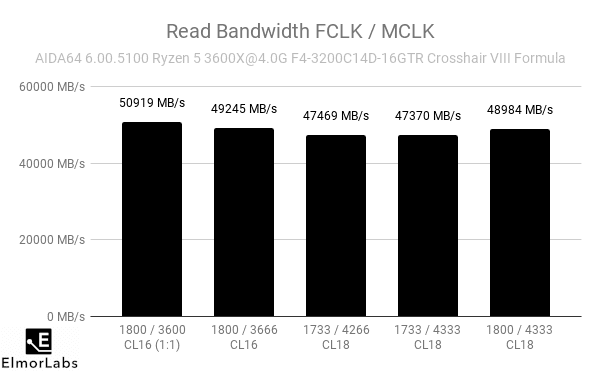AMD Ryzen 3000 Memory / Fabric (X370/X470/X570)
This is a brief summary with limited testing to highlight changes to memory and fabric behavior on Zen 2 (Matisse).
As you've probably seen, Ryzen 3000 is capable of much higher memory speeds than previous generations. The main reason for this is added circuitry on-chip that allows running the memory clock (MCLK) asynchronous from the fabric clock (FCLK). While this enables higher memory frequency, it also increases access latency because the data travelling across different frequency domains has to be synchronized.
The below tests try to answer the following questions:
- How high memory frequency can be expected with Ryzen 3000 on X370/X470/X570?
- How high fabric clock can be expected?
- Is there a benefit to high memory frequency and high fabric clock?
- How big is the latency penalty when running MCLK != 2*FCLK?
An issue with these tests is that BIOS releases are at this time very unpolished. There are new AGESA versions and patches released frequently which board vendors struggle to keep up with. Especially X370 and X470 versions are problematic for memory overclocking. Both the AMD memory initialization method and vendor DRAM settings seem not to not be working or lack tuning. At best these tests will be able to hint at how things will be for end users.
- CPUs: AMD Ryzen 5 3600X
- Motherboards:
- ASUS ROG Crosshair VI Hero (X370) BIOS 7106 AGESA 1.0.0.2
- ASUS ROG Crosshair VII Hero (X470) BIOS 2406 1.0.0.2
- ASUS ROG Crosshair VIII Formula (X570) BIOS 7702 1.0.0.3
- Memory: G.Skill Trident Z RGB F4-3200C14D-16GTR (2x8GB Samsung B Single-Rank)
- Settings
- CPU: Default in RamTest, 4.0G 1.25V in AIDA64 tests
- SOC Voltage: 1.25V
- DRAM Voltage: 1.40V (DRAM Boot Voltage = 1.40V)
- Timings CL16: 16-16-16-16-45-1T-GD En
- Timings CL18: 18-18-18-18-45-1T-GD En
Issues
C6H 7106: DRAM Voltage at the beginning of POST is always 1.200V which limits the max memory frequency. It's possible to work around by first booting with lower DRAM Frequency and higher voltage, then only increasing DRAM Frequency in steps without the board shutting down.
C7H 2406: DRAM Vboot is always 1.200V by default, it can be manually set instead. However the setting is lost after standby power is removed from the motherboard.
C6H 7106 + C7H 2406: After failing memory overclocking you get stuck at C5 POST code which never seems to recover. The only way to get back is to clear CMOS.
Results and discussion
This shows the highest DRAM Frequency that would pass 100% in RamTest with 2x8GB Samsung B-die. 1.25V SOC and 1.40V DRAM Voltage was used in all cases. These settings are not considered 100% stable and are only an indicator of what's possible without much tuning. I plan to test and update with additional configurations but am currently lacking the time. Above 4000 MHz with 2x16GB has been demonstrated on C8F. The tests were completed at 1733 MHz FCLK, anything higher would cause stability issues. Up to 1900 MHz FCLK is possible on some chips, which will depend on the chip quality. Adjusting SOC and VDDG voltages may help to stabilize higher speeds. The C7H was getting surprisingly close to the C8F, both using "Daisy Chain" memory layout topology. The C6H with its "T" topology is doing much worse, likely because of less time spent tuning signaling parameters at this point. These numbers are expected to improve with the next couple of BIOS releases.

Setting MCLK = 2*FCLK (1:1) yields by far the highest read bandwidth at FCLK / MCLK = 1800 / 3600. Increasing DRAM Frequency by one step to 3666 MT/s while keeping the fabric at 1800 MHz reveals the penalty when using asynchronous clock domains. The read bandwidth immediately drops 1.7 GB/s. At higher memory speeds and CAS Latency, it can see how fabric and memory clocks scale. Increasing DRAM Frequency from 4266 MT/s to 4333 MT/s at the same 1733 MHz fabric clock doesn't increase read bandwidth. Instead with DRAM Frequency fixed at 4333 MT/s, increasing FCLK from 1733 MHZ to 1800 MHz immediately shows a gain of 1.6 GB/s.
Due to Infinity Fabric redesign between CCD and IOD the memory write bandwidth is half on CPUs with only 1xCCD (<=8C) compared to previous generations (see
https://hexus.net/tech/reviews/cpu/1...ryzen-7-3700x/). This is clearly reflected in these results, where the bandwidth only seem to depend on the fabric speed.
Moving away from synchronous memory/fabric clocks doesn't hurt copy bandwidth by much, and it seems to scale nicely both with increased memory and fabric speeds.
As mentioned in AMD's own presentation, the main issue with asynchronous clock domains is the latency penalty. Changing settings from 1800 / 3600 synchronous to 1800 / 3666 asynchronous increases latency by a whooping 10.6 ns. The difference is slowly reduced as memory and fabric clocks are increased, but never fully recovers.
Summary
- X370/X470 BIOS is still immature when using Ryzen 3000 (depending on the board)
- Highest achieved memory frequency was 4333 MT/s on X570, 4200 MT/s on X470 and 3666 MT/s on X370. The results will most likely get closer with BIOS updates.
- Fabric clock target 1700-1900 MHz
- Memory latency penalty ~10ns when moving from synchronous to asynchronous memory/fabric clock, which can be reduced by further increasing memory frequency
- Highest possible fabric clock with memory synchronized (MCLK = 2*FCLK) yields the highest read bandwidth and lowest latency
- Write bandwidth only scales with fabric clock
- Copy bandwidth benefits from both memory and fabric clock, and is not hurt much by increased latency
 aber ich hatte auch nur 850 Euro
aber ich hatte auch nur 850 Euro 











 )
) Vielleicht besorgt mir JZ_ eins davon zum Sonderpreis, dann mache ich auch einen Sammelthread dazu hier auf.
Vielleicht besorgt mir JZ_ eins davon zum Sonderpreis, dann mache ich auch einen Sammelthread dazu hier auf. 